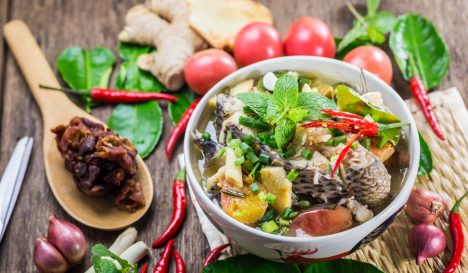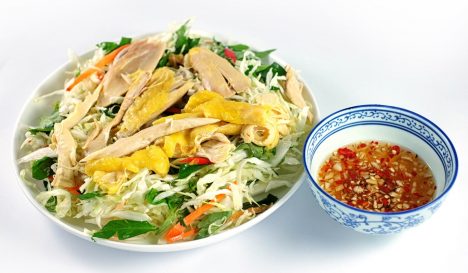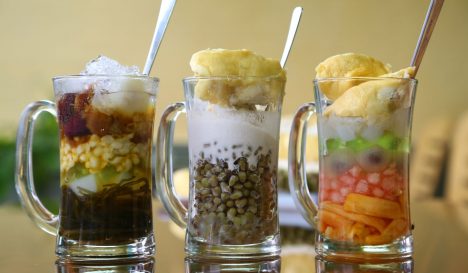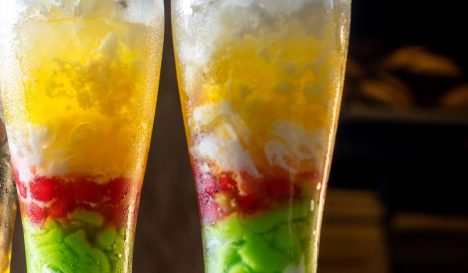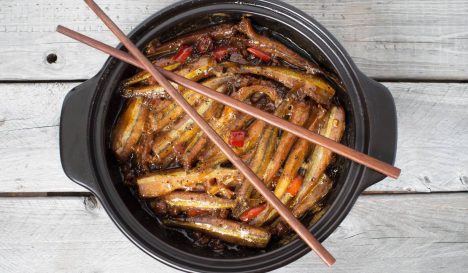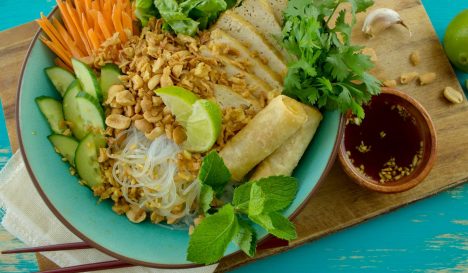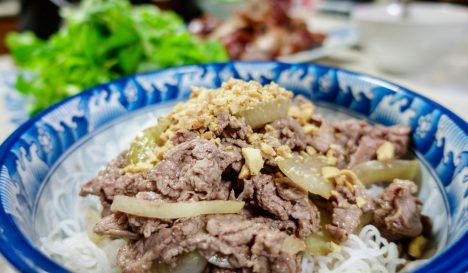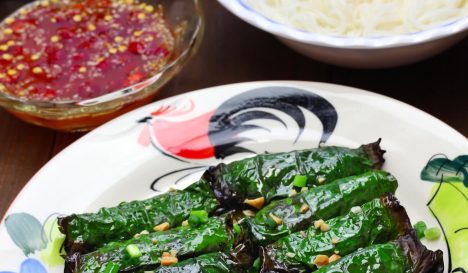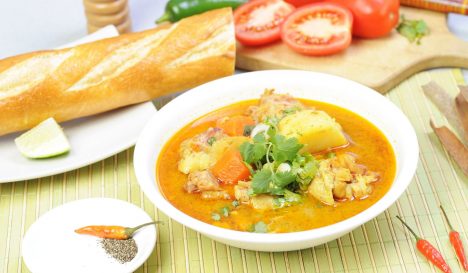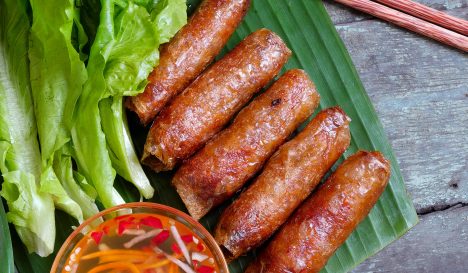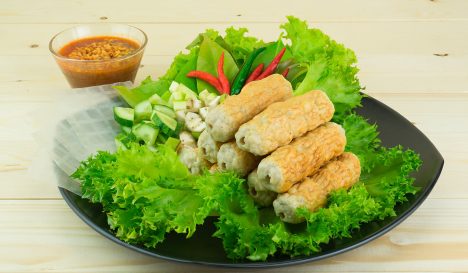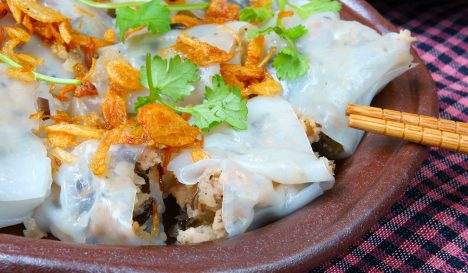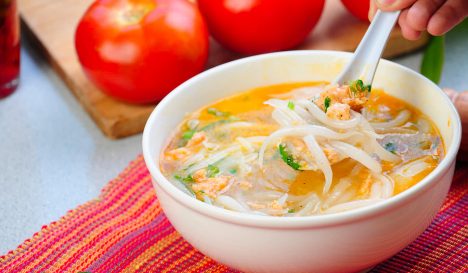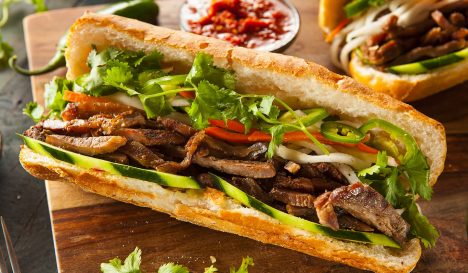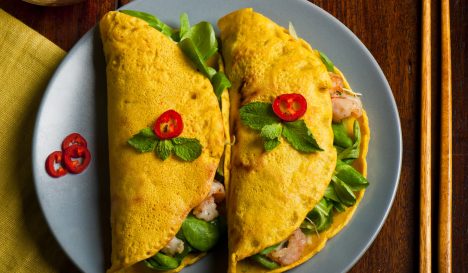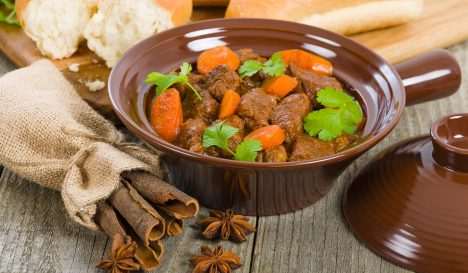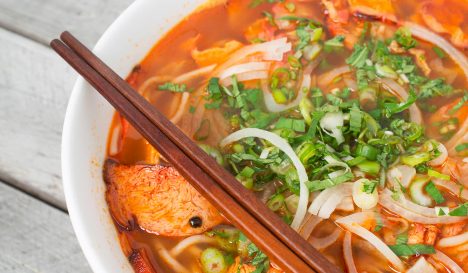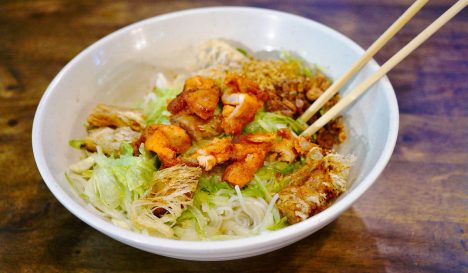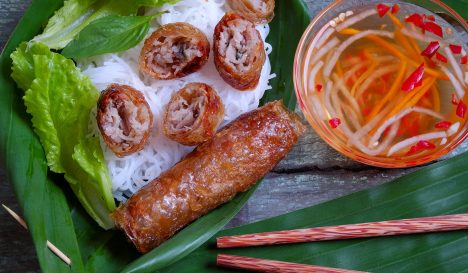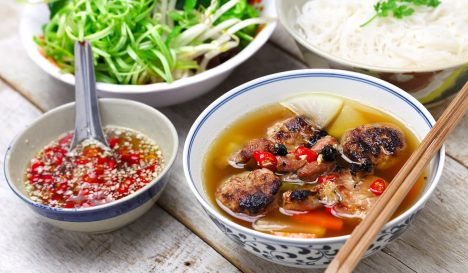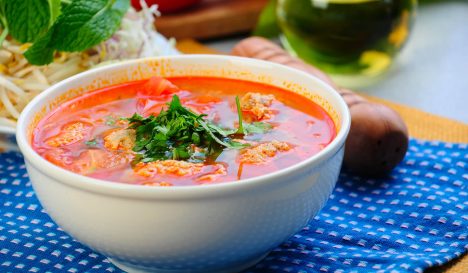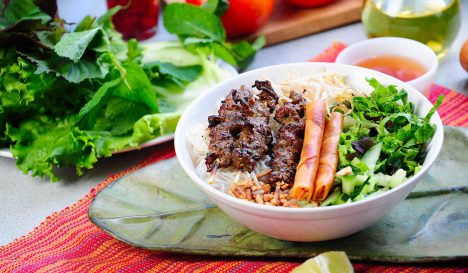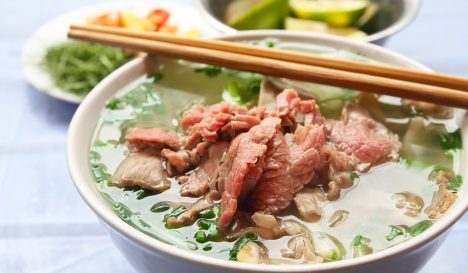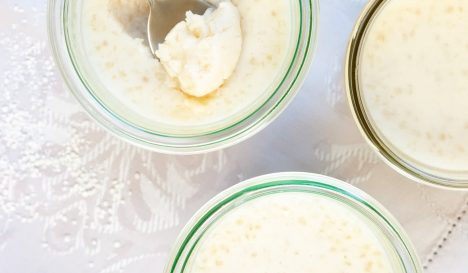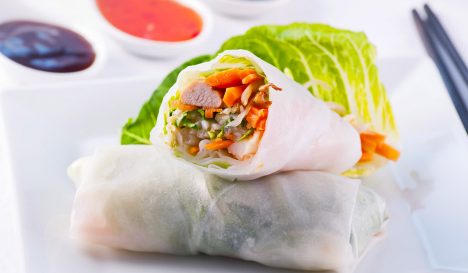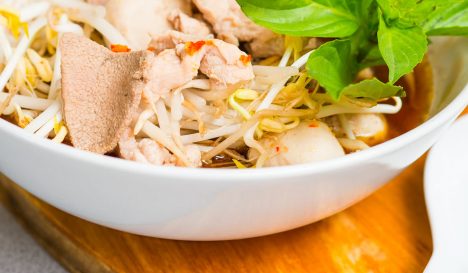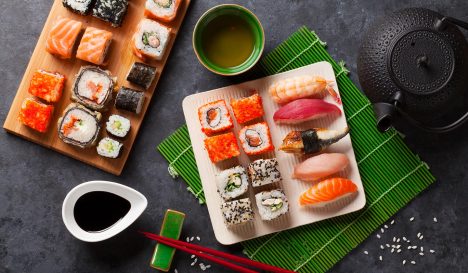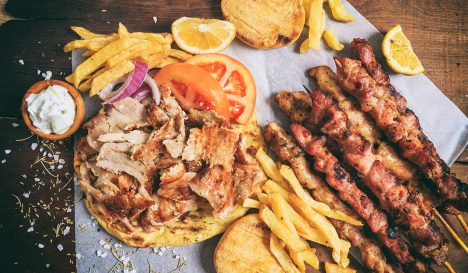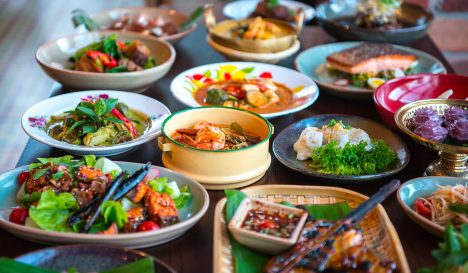Vietnamese cuisine
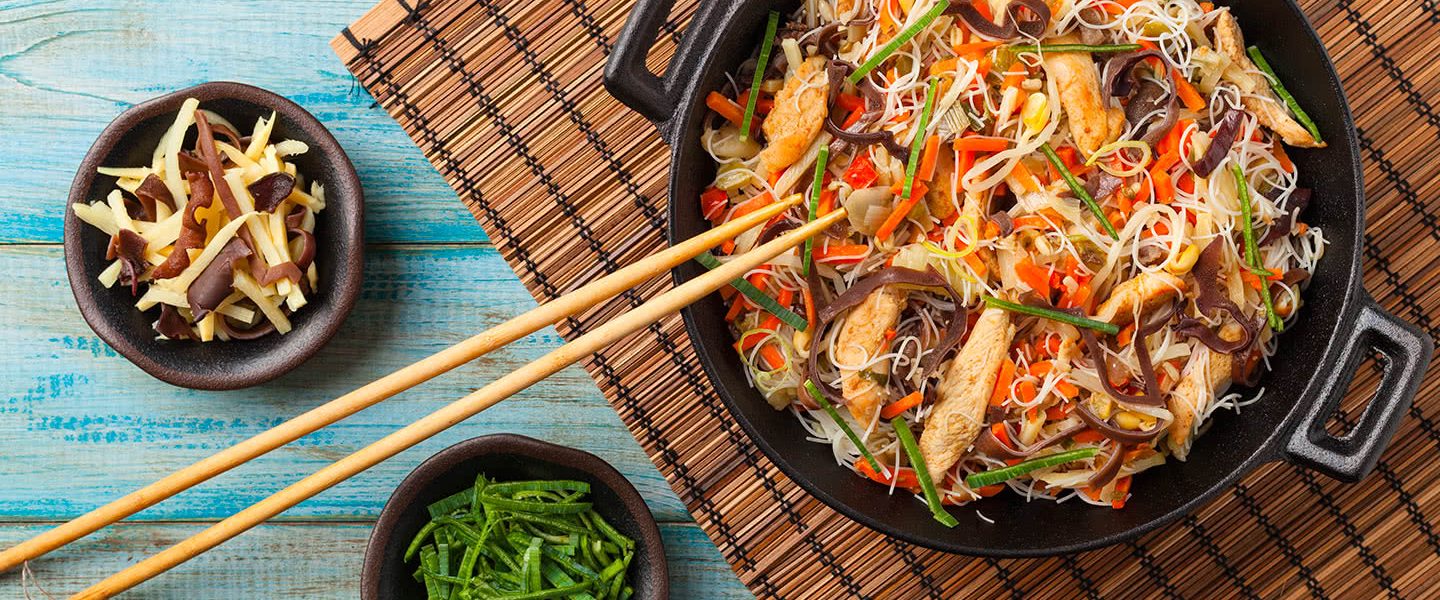
Vietnamese cuisine is one of the subtlest cuisines in Asia. The flavours are light, fresh and layered without being overstated. The balance between sweet, sour, salty and hot elements is important. Each dish has an interplay of opposites: hot versus cold, soft versus crispy, fresh versus fermented. Vietnamese is one of the healthiest cuisines in the world.
- Outside influences
- Typical ingredients
- Best accompaniment
- Vietnamese Table Manners
- Vietnamese cuisine in Canada
- For beginners
- Also try
- Discover these Vietnamese dishes
Outside influences
Although Vietnam is not a large country, it is extremely long. The coastline extends for no less than three thousand kilometres and the country shares borders with China, Laos and Cambodia. In the northern regions, you will also find Chinese influences, such as stir-fry dishes and noodle soups. If you travel further south, the dishes become sweeter and people use more coconut milk.
The French colonisation, which began in the eighteenth century and lasted until 1954, also left its mark. Dishes such as banh mi, a baguette-like sandwich filled with pâté amongst other things, were once intended to combat the homesickness of the French occupiers. Thanks to the French, there is also plenty of meat on the menu, especially beef, although the inhabitants mainly used other meats during colonisation, while the French took the steak.
Typical ingredients
Rice (com) is the most important ingredient. As soon as you leave the city on your moped as a tourist, you’ll ride between rice fields. Sufficient grains are grown to feed the entire population of over ninety million people! And Vietnam is still one of the world’s largest exporters. The Vietnamese eat bowls of fragrant steamed boiled rice, as well as rice noodles, rice sheets, rice pancakes, rice desserts, puffed rice snacks – and they drink rice wine.
If there is another typical ingredient of Vietnamese cuisine, it has to be nuoc mom (nước mắm, pronounced “noewk mom”). This fish sauce differs from fish sauces in other Asian countries and gives Vietnamese dishes a distinct character. The sauce is made by salting good quality fish, often anchovies, and allowing it to ferment in large barrels for up to a year. Just like a good balsamic vinegar or whiskey, the taste of this fish sauce improves the longer it matures. There are all kinds of regional differences in colour and taste because nuoc mam makers use their own special fish and secret ingredients.
Vietnamese scarcely use dairy. The one exception comes in the form of small, innocent-looking cans: sweetened condensed milk. The intensely sweet stuff is used in desserts, but especially in coffee (ca phe; see below).
Best accompaniment
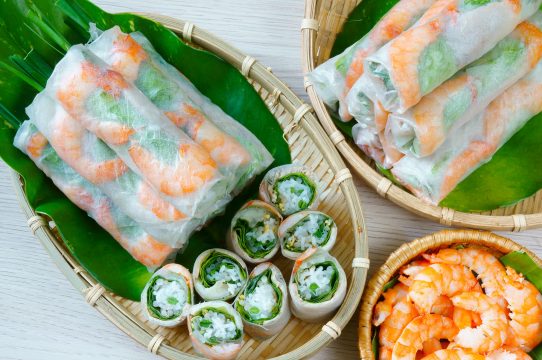
Vietnamese food is distinguished by its side dishes. Very rarely does a plate or dish come along without a matching dish with fresh herbs and vegetables, such as cucumber, bean sprouts and spring onion. Aromatic herbs are a must. They are supposed to be very fresh and add flavour, smell, colour and texture to many dishes; from bun thit nuong to goi cuon. Examples of frequently used herbs are coriander, Vietnamese mint, Thai basil and Chinese chives.
In addition, a small bowl of nuoc cham (nước chắm, pronounced “noewk tsjem”), Vietnamese dipping sauce, appears as if by default. It is a side dish that the Vietnamese feel goes with everything. Nuoc cham is made by diluting fish sauce with lime juice and seasoning with chilli pepper, sugar and garlic. Nuoc cham also delivers that important balance of sweet, sour, hot and salty.
Other popular condiments are do chua (đồ chua; pickled daikon and carrot) and mo hanh (mở hành; spring onions in oil).
Vietnamese Table Manners
- The plate of the oldest man at the table – usually the man of the house – is the first to be served. Only when the man starts eating can the rest of the table take a bite. It is an old-fashioned habit that is still very common.
- Wish everyone “Bon Appetit” in the right age order (from old to young) before you start eating.
- Do not leave your chopsticks upright in the bowl. This is a rude gesture because it is reminiscent of the incense sticks that are sacrificed to the dead on altars.
- In Vietnam, “food waste” (such as chicken bones, seeds and other non-food leftovers) is placed directly on the table, or even thrown on the floor. It is cleaned up at the end of the meal.
- Never eat straight from the pan or serving dish. Put all food first in your bowl, then into your mouth. Food is also not passed from chopstick to chopstick. If you want to serve someone something, put it in his or her bowl.
- Every bowl of Vietnamese food is first “pimped” or, in fact, personalised. Each person adds herbs, bean sprouts, chilli sauce or other extras to their own taste. Some people also first adjust their dish of dipping sauce as desired before they start. Everything goes and you don’t have to worry about insulting the chef.
Vietnamese cuisine in Canada
Vietnamese cooking has become extremely popular with Canadians over the past several years, led by Pho (pronounced ‘fuh’), a hearty combination of broth, rice noodles, herbs, and meat or fish. No coincidence then that you’ll find Skip has hundreds of Vietnamese restaurants listed in the app. If you’ve never had an iconic dish like Pho before, open the Skip app to find the best Vietnamese restaurants near you.
You don’t know what you’re missing if you’ve never ordered from one of these Vietnamese restaurants with Skip in Burnaby, Leduc, and Mississauga.
For beginners
If you are new to Vietnamese cuisine, try the following dishes and you will get a good overview of what the country has to offer:
Appetiser
Goi cuon – These are freshly rolled salad rolls filled with rice vermicelli, fresh raw vegetables and herbs, and shrimp or fish.
Soup:
Pho – This noodle soup of flat rice noodles, beef broth, beef and fresh herbs is the most famous dish from Vietnam.
Main:
Bun cha gio – A salad of cold rice noodles, crispy vegetables and peanuts is topped with pieces of delicious Vietnamese spring roll.
Dessert:
Che chuoi – Everyone adores this soup-like pudding made with coconut, tapioca and banana.
Also try
Vietnamese ca phe (cà phê, pronounced “kaa fee”) can be drunk hot or as iced coffee (ca phe sua da). The drink is strong and sweet, thanks to the thick layer of sweetened condensed milk added to it. If you choose hot coffee, you’ll get a mini filter on top of a small glass with condensed milk in the bottom. Wait patiently until the coffee has filtered, and then stir in the milk and drink it in a gulp. Or you can delicately sip it. Be prepared for a big hit of caffeine that you’ll be addicted to after just one cup.

